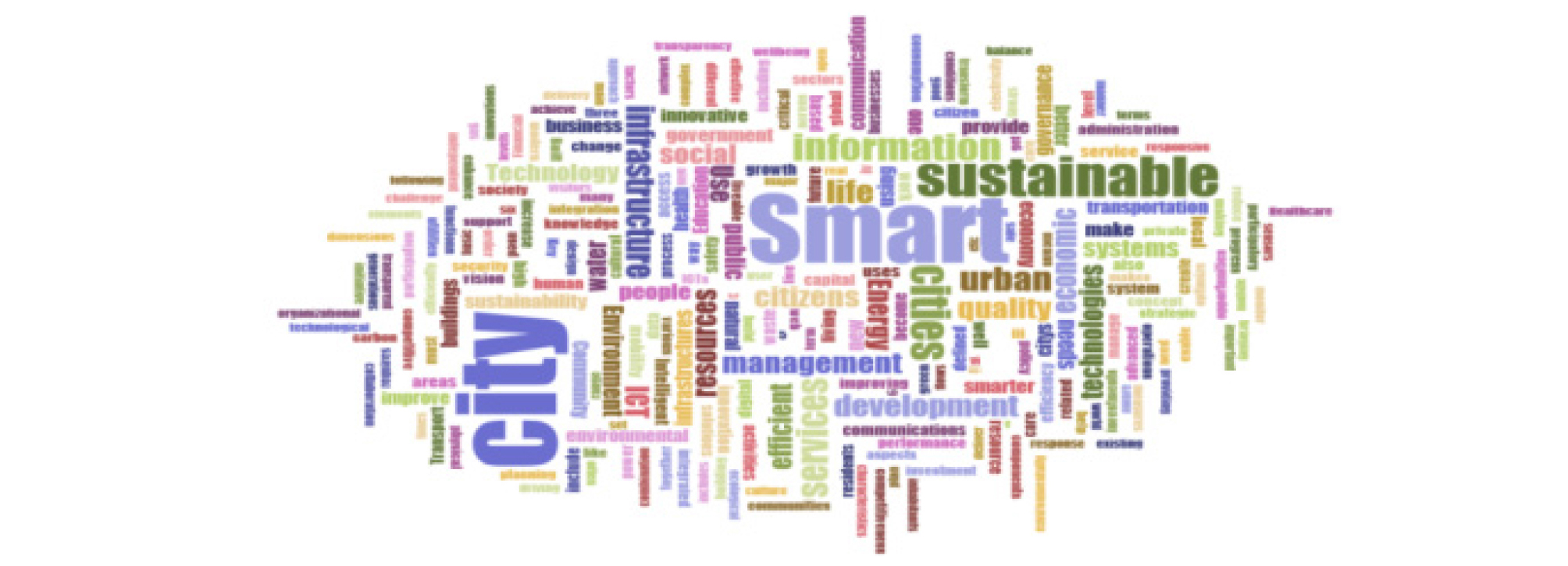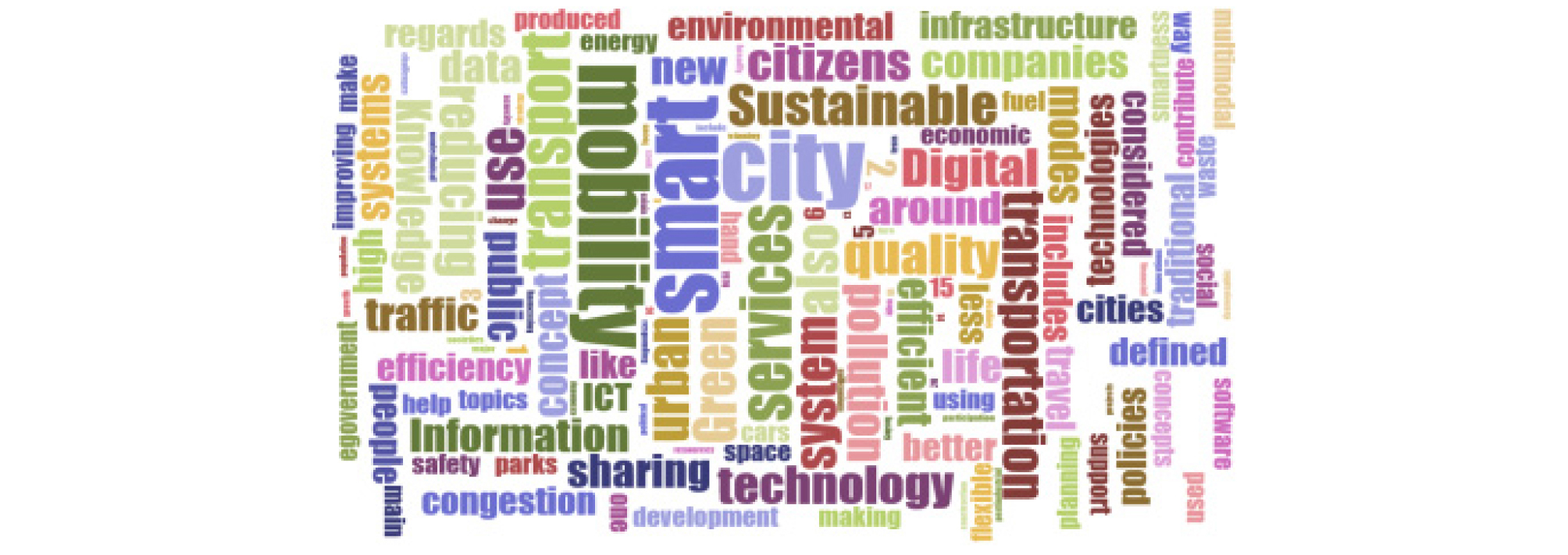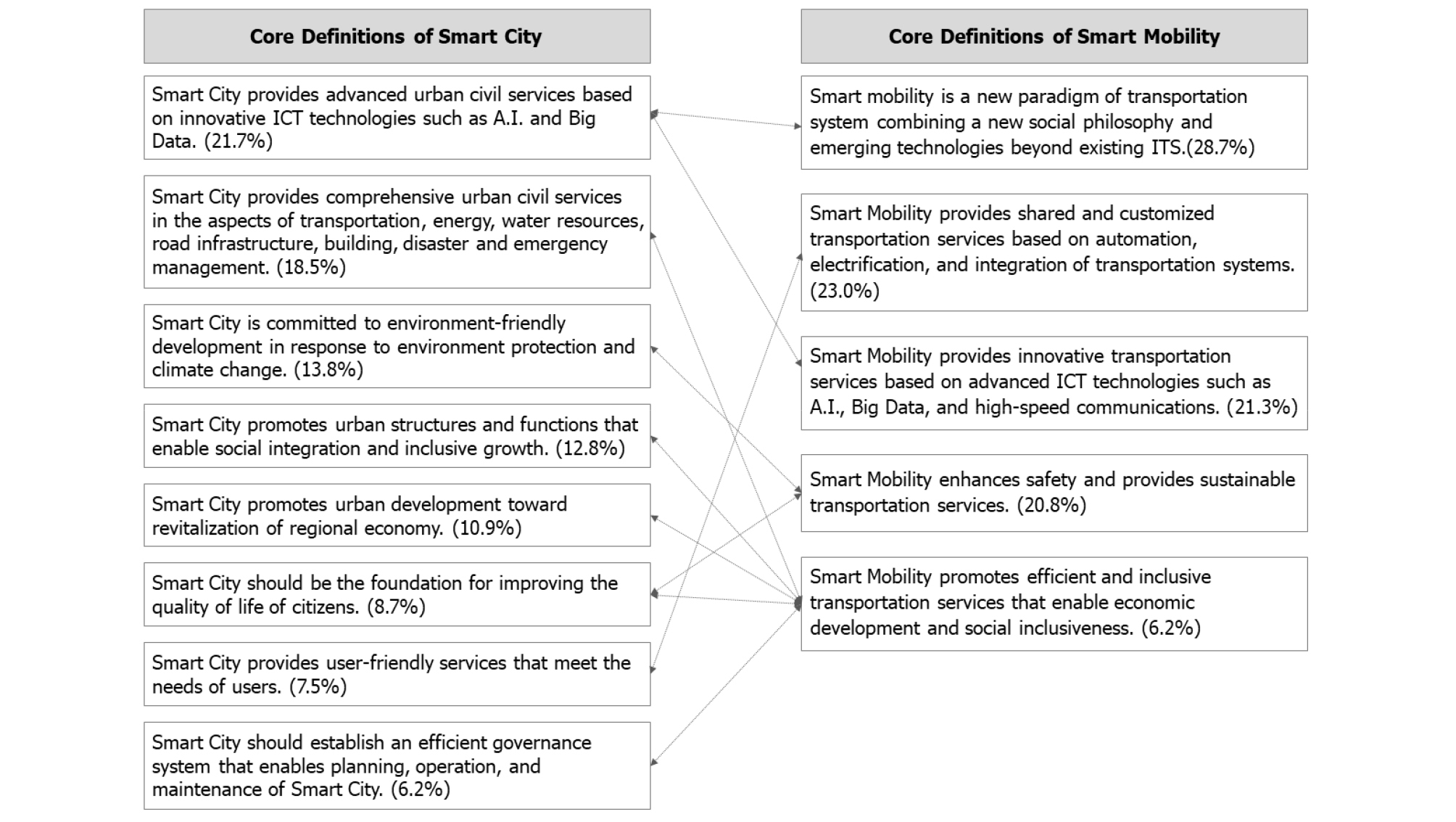서론
스마트시티는 자율주행차, 공간정보, 스마트홈, 드론 등과 같은 각종 신산업이 실질적으로 실증되고 구현되는 혁신의 공간으로 신산업 창출을 위한 대표적인 플랫폼이자 미래 성장동력으로 일컬어지고 있다. 4차산업혁명에 선제적으로 대응하고 신성장동력 창출을 위하여 최근 선진국과 개발도상국의 구분 없이 전 세계 수많은 국가에서 경쟁적으로 스마트시티 건설을 계획하고 있으며, 2014년 기준으로 600여개 이상의 스마트시티 관련 프로젝트가 계획되고 있거나 추진되고 있다(KRIHS, 2016). 우리나라 역시 2000년대 들어 세계 최고 수준의 정보통신인프라를 활용하여 유비쿼터스시티(u-City) 관련 다양한 프로젝트들을 추진하여 왔고, 4차산업혁명 융합기술의 발전으로 현재의 스마트시티 사업들로 이어지고 있다(Moon and Park, 2015; Park and Ko, 2009; Park et al., 2010; Bin et al., 2013; Cheong, 2018; Choi et al., 2012). 4차산업혁명 기술 기반의 신도시 건설 개념과 더불어 스마트시티는 전 세계적으로 도시화에 따른 자원 및 인프라 부족, 교통혼잡, 에너지 부족 등 각종 도시문제의 효율적 해결방안으로서도 각광 받고 있다. 우리나라 역시 적극적인 스마트조성 및 확산을 위해 2022년까지 ‘지속 가능한 스마트시티 혁신 모델 및 플랫폼’ 구현 계획을 가지고 있으며, 스마트시티 관련 국가연구개발프로젝트 및 시범사업 등이 추진되고 있다(KAIA, 2018).
다만, 스마트시티에 대한 개념 및 개발목표는 각 나라별 환경과 도시문제 인식에 따라 다양하게 적용되고 있으며, 개발도상국들 위주로 스마트시티는 도시화에 따른 문제해결 측면의 개념들이, 선진국들은 기후변화협약 대응, 도시재생, 신도시 개발 차원에서 스마트시티 사업들이 진행되고 있다. 그 예로, 인도 등 개발도상국에서는 스마트시티의 우선적인 목적으로 충분한 물 공급과 보장된 전기 공급, 고형 폐기물 관리를 포함한 위생시설 등으로 정의하고 있고, 유럽국가들에서는 스마트시티는 시민들의 안전을 보장하고 도시서비스를 향상시키기 위한 첨단기술 기반의 혁신도시라고 정의하고 있다(Aijaz, 2016; Faergemann, 2018). 국제전기통신연합에 따르면 스마트시티에 대한 정의는 각 나라별 환경 및 특성에 따라 다양하며 전 세계에 스마트시티 정의의 수가 116개에 이른다고 한다. 국제전기통신연합은 각 나라별 스마트시티 정의내용을 바탕으로 아래와 같이 정의하였다(ITU, 2014).
“현재와 미래의 문화적, 경제적, 사회적, 환경적 측면에서의 요구를 반영하여 ICT 등의 첨단기술 기반의 도시기능 효율화 및 경쟁력 강화, 삶의 질 향상을 위한 서비스를 제공하는 혁신적인 도시(A smart sustainable city (SSC) is an innovative city that uses information and communication technologies (ICTs) and other means to improve quality of life, efficiency of urban operation and services, and competitiveness, while ensuring that it meets the needs of present and future generations with respect to economic, social and environmental aspects)”
또한, UN(2016)은 기술적, 물리적, 공간적 접근에 환경 및 거버넌스와 같은 사회적 이슈 등을 포함한 포괄적 측면의 스마트시티 개념을 제시하였다. UN의 스마트시티 정의는 스마트 교통, 스마트 경제, 스마트 생활, 스마트 거버넌스, 스마트 피플, 스마트 환경으로 크게 6가지 영역으로 구분하여 제시하고 있다. 국내의 경우 The Korea Transport Institute(2016)에서는 스마트시티는 ‘스마트시티 통합플랫폼에서 생성되는 모든 정보를 유기적으로 연계 및 통합하여 사용자에게 스마트 한 교통서비스를 제공하는 안전성 ‧ 신속성 ‧ 쾌적성 ‧ 편리성 ‧ 친환경성이 최적화된 교통시스템’으로 정의하고 있다.
이와 같이 스마트시티 사업을 추진 중인 국가 또는 도시마다 다양한 개념의 정의가 존재함에 따라 스마트시티의 가장 핵심적인 인프라 중 하나인 스마트시티 교통부문에 대한 명확한 개념 역시 정립되어 있지 않다. 스마트시티 교통부문에 대한 개념 정의의 불명확은 스마트시티 교통체계의 역할 및 구축 방향, 스마트시티 교통서비스 등에 대한 전반적인 목표 및 구축전략이 부재한 주요 원인으로 지목되고 있다. 우리나라 역시 스마트시티와 스마트시티 교통부문에 대한 명확한 정의가 없어, 그 정의에 따른 스마트시티 및 스마트시티 교통부문의 핵심구성요소 및 구성요소별 구축전략 등이 미비한 상황이다.
따라서 본 연구는 전 세계에 존재하는 스마트시티와 스마트시티 교통부문에 대한 정의요소들의 공통사항들에 기반한 스마트시티와 스마트시티 교통부문의 개념을 정립하고자 한다. 본 연구에서 제시하는 스마트시티와 스마트시티 교통부문의 개념 정립은 향후 국내 스마트시티 사업이 지향해야 할 목표를 설정하는 측면에서 중요한 의의를 가지며, 스마트시티와 스마트시티 교통 부문의 주요 서비스 발굴 및 추진시 본 연구에서 제시하는 개념을 고려할 수 있을 것으로 기대된다. 이를 위해 전 세계 스마트시티와 스마트시티 교통부문의 정의내용들을 수집하였고, 빅데이터 분석방법 중 하나인 텍스트마이닝 기법을 활용하여 정의내용에 포함된 단어별 빈도분석을 수행하였다. 자주 언급된 단어들일수록 스마트시티와 스마트시티 교통부문을 정의하는 핵심내용이라는 가정 하에, 빈도 수가 높은 단어들을 추출하여 범주별로 분류하고, 그 단어범주별 핵심개념들의 조합에 기반한 개념정립을 수행하였다.
연구방법론
본 연구는 스마트시티와 스마트시티의 구성요소 중 핵심 인프라인 교통부문에 대한 개념을 정립하고자 한다. 스마트시티와 스마트시티 교통부문의 개념 정립을 위하여 현재 국내 ‧ 외에서 사용되고 있는 스마트시티와 스마트시티 교통부문에 대한 다양한 정의내용을 수집하였다. 스마트시티 교통부문의 경우 국내 ‧ 외 다양한 연구 및 사업들에서 스마트모빌리티(Smart Mobility)로 대표되고 있어 본 연구에서는 스마트시티 교통부문에 대해 스마트모빌리티의 정의내용을 활용하였음을 밝힌다. 참고로, 스마트시티 교통부문의 서비스와 스마트모빌리티 서비스에서 모두 공통적으로 통합모빌리티, 스마트주차, 자율주행대중교통 서비스 등이 제안되고 있으므로, 스마트시티 교통부문에 대한 정의 조사시 스마트모빌리티의 정의내용을 활용함은 합리적인 것으로 판단된다. 수집된 정의들은 C# 프로그래밍 기반의 텍스트마이닝 기법을 통해 정의에 활용된 단어별 빈도분석을 실시하였으며, 문장의 조사 및 특정 위치 등을 지칭하는 단어들을 제외한 단어들에 대해 빈도와 함께 제시하였다. 스마트시티와 스마트시티 교통부문의 개념 정립 시 텍스트마이닝 기법을 사용한 이유는 현재 전 세계에 스마트시티와 스마트시티 교통부문에 대해 모두가 인정할 수 있는 사례가 부족하므로, 각종 학술보고서 등에서 정의된 전문가들의 의견을 종합하고 그 첨단(혹은 지향점)에 있는 스마트시티와 스마트시티 교통부문의 정의를 파악하기 위함이다. 이러한 텍스트마이닝 기법은 방대한 양의 자료분석이 필요한 연구에 다수 활용되어 왔으며, 그 예로 교통사고자료 기반 사고원인 분석 연구(Gao and Wu, 2013), 소셜네트워크 데이터 분석 연구(Hong et al., 2017), 온라인뉴스 분석 기반 자율주행자동차의 인식 변화 연구(Im et al., 2017) 등에 활용된 바 있다.
1차 빈도분석 결과에 따른 단어들은 그 수가 많고 단어들 간 유사한 의미를 가지는 경우가 많다. 또한, 단어들 간 의미가 다르더라도 같은 범주 안에서 설명할 수 있는 단어들이 존재한다. 예를 들어 ‘paradigm shift’와 ‘trend change’의 경우 ‘paradigm shift’로 통일하여 표현할 수 있고, ‘recycling’과 ‘emission reduction’의 경우 ‘sustainability’의 범주에 포함될 수 있다. 이와 같이, 유사한 의미를 가진 단어들과 같은 범주 내에서 설명 가능한 단어들을 모아 범주별 분류를 수행하였다. 이렇게 구성된 단어별 범주는 스마트시티 혹은 스마트모빌리티의 핵심적인 정의요소라 간주하여, 단어범주별 핵심개념들을 조합한 정의를 제시하였다. 앞에서 설명한 스마트시티와 스마트모빌리티의 정의 도출 과정에 대한 흐름도는 Figure 1과 같다.
스마트시티의 개념 정립
스마트시티 정의 수집을 위해 ITU(2014)에서 조사한 116개 스마트시티 정의를 활용하였다. 116개 정의 중 주요 정의 및 해당 정의내용에 포함된 핵심단어들은 Table 1과 같다.
Table 1. Definitions of smart city
| Source | Definitions | Keywords |
| Bakıcı et al.(2012) |
Smart city as a high-tech intensive and advanced city that connects people, information and city elements using new technologies in order to create a sustainable, greener city, competitive and innovative commerce, and an increased life quality. |
high-tech, people, information, technologies, sustainable, innovative, life quality |
| Barrionuevo et al.(2012) |
Being a smart city means using all available technology and resources in an intelligent and coordinated manner to develop urban centers that are at once integrated, habitable, and sustainable. |
technology, intelligent, develop, integrated, sustainable |
| Caragliu et al.(2011) |
A city is smart when investments in human and social capital and traditional (transport) and modern (ICT) communication infrastructure fuel sustainable economic growth and a high quality of life, with a wise management of natural resources, through participatory governance. |
transport, ICT, communication, infrastructure, sustainable, economic, growth, quality of life management, governance |
| Chen(2010) |
Smart cities will take advantage of communications and sensor capabilities sewn into the cities' infrastructures to optimize electrical, transportation, and other logistical operations supporting daily life, thereby improving the quality of life for everyone. |
communication, infrastructure, transportation, quality of life |
| Guan(2012) |
A smart city, according to ICLEI, is a city that is prepared to provide conditions for a healthy and happy community under the challenging conditions that global, environmental, economic and social trends may bring. |
healthy, happy, environmental, economic, social |
| Hall(2000) |
A city that monitors and integrates conditions of all of its critical infrastructures, including roads, bridges, tunnels, rails, subways, airports, seaports, communications, water, power, even major buildings, can better optimize its resources, plan its preventive maintenance activities, and monitor security aspects while maximizing services to its citizens. |
integrates, infrastructures, communications, water, services |
| BIS(2013) |
The UK Department for Business, Innovation and Skills (BIS) considers smart cities a process rather than a static outcome, in which increased citizen engagement, hard infrastructure, social capital and digital technologies make cities more liveable, resilient and better able to respond to challenges. |
innovation, infrastructures, social, technologies, liveable |
| Duckenfield(2014) |
less frequently) include "technology", "connected", "internet" and "modern". |
technology, connected, internet, modern |
위의 116개 스마트시티 정의내용에 대한 C# 프로그래밍 기반의 텍스트마이닝 기법을 적용하여 단어별 빈도를 분석하고 유의미한 단어들을 추출한 결과 40종의 스마트시티 핵심정의 단어들이 선정되었고, Figure 2와 같은 시각화 결과 및 Table 2와 같은 빈도분석결과가 도출되었다.
Table 2. Frequencies of the Smart City definition keywords
핵심정의단어 40종에 대한 빈도분석 결과, 첨단기술을 의미하는 ‘ICT’ 및 ‘Technology’가 94회(10.1%)로 가장 많이 언급되었다, 그 다음으로 ‘Sustainability’ 89회(9.6%), ‘Infrastructure’ 59회(6.4%), ‘Information’ 50회(5.4%), ‘Service’ 49회(5.3%), ‘Quality of Life’ 44회(4.7%), ‘Governance’ 37회(4.0%)로 분석되었다. 이 밖에도 ‘Inclusive’가 34회(3.7%), ‘Liveability’가 12회(1.3%) 언급된 것으로 나타나, 국내 스마트시티 사업추진 시 강조되는 시민 체감과 포용적 서비스 제공 철학에 부합 하는 단어들 역시 국내 ‧ 외 스마트시티 정의에 포함되는 것으로 나타났다.
추출된 40종의 핵심정의단어들을 대상으로 유사한 의미를 가진 단어들끼리 범주를 만들어 분류하였다. 단어별 범주를 구분하기 위해, 추출된 정의요소단어들은 기술진보를 의미하는 단어들과 그 외 단어들로 구분되었으며, 기술적 의미를 담지 않은 단어들에 대해서는 환경, 경제, 복지 등과 같이 일반적으로 차별화되는 분야라 여겨지는 범주로 구분하여 분류되었다. 그 결과 총 8개의 범주가 구성되었으며, ‘ICT’, ‘Technology’, ‘Innovation’ 등의 기술을 의미하는 단어들은 ‘ICT 혁신기술’ 범주에, ‘Transport’, ‘Energy’, ‘Infrastructure’ 등은 ‘도시기능 향상’ 범주에, ‘Sustainability’, ‘Environment’ 등은 ‘환경 및 기후변화 대응’ 범주에 포함하였다. 또한, ‘Social’, ‘People’, ‘Integration’과 같은 단어들은 ’사회통합 및 포용성’ 범주에, ‘Economy’, ‘Welfare’ 등은 ‘경제개발 및 성장’ 범주에, ‘Quality of life’, ‘Liveability’ 등은 ‘삶의 질 향상’ 범주에, ‘Service’, ‘Needs’ 등은 ‘시민 서비스’ 범주에, ‘Administration’, ‘Management’ 등은 ‘거버넌스’ 범주에 분류하여 포함하였다. 또한, 스마트시티의 핵심 구성요소 중 하나인 교통과 관련된 단어(‘Transport’, ‘Mobility’)가 32번 언급(3.5%)되어, 교통 분야가 스마트시티의 기능 중 하나로 인식되고 있는 것으로 보이나 스마트시티의 개념 안에서의 중요성 측면에서 좀 더 강조될 필요가 있을 것으로 보인다. 앞에서 언급한 핵심정의단어별 범주화 결과는 Table 3과 같다.
Table 3. Categorization of the Smart City definition keywords
Table 3의 범주분류를 바탕으로 스마트시티는 다음과 같이 8가지 요소로 정의될 수 있다.
(1) 스마트시티는 인공지능과 빅데이터 등 첨단 ICT 혁신기술 기반의 도시서비스를 제공한다.
(2) 스마트시티는 교통, 에너지, 수자원, 도로교통인프라, 건축, 재난 및 긴급상황 대처 등 종합적인 도시기능 향상을 포함한 서비스를 제공한다.
(3) 스마트시티는 환경보호 및 기후변화 대응을 위한 친환경적 개발을 지향한다.
(4) 스마트시티는 사회통합 및 포용적 성장이 가능한 도시기반을 구축한다.
(5) 스마트시티는 도시경제 활성화를 궁긍적인 목표로 도시개발을 추진한다.
(6) 스마트시티는 시민들의 삶의 질을 향상시키기 위한 토대가 되어야 한다.
(7) 스마트시티는 시민들의 요구에 부합하는 국민체감형 서비스를 제공한다.
(8) 스마트시티는 스마트시티의 계획 ‧ 실현 ‧ 유지관리가 가능한 거버넌스체계를 구축해야 한다.
위의 요소에 기반하여 종합하였을 때, 스마트시티란 “첨단 ICT 기술을 활용하여 시민들의 삶의 질을 향상시키고, 도시경제를 활성화할 수 있는 포용력과 경쟁력이 있고 지속 가능한 국민 체감형 종합 도시관리 서비스를 제공하는 체계”로 정의할 수 있다.
스마트시티의 교통부문 개념 정립
스마트시티의 정의에 비해 스마트시티 교통부문(스마트모빌리티)에 대한 정의 및 주요 특징에 대한 연구는 많지 않다. 스마트모빌리트 정의 수집을 위해 각종 연구보고서 등에서 언급한 스마트 모빌리티 정의를 조사하였다. 28개 정의 중 주요 정의 및 해당 정의내용에 포함된 핵심단어들은 Table 4와 같다.
Table 4. Definitions of Smart Mobility
| Source | Definitions | Keywords |
| Siemens(2015) |
Smart mobility is a paradigm shift to a more flexible and multi-modal transport system to a multi-modal system with high flexibility and convenience. |
smart, mobility, flexible, multi-modal, convenience |
| Benevolo et al.(2016) |
Smart Mobility is largely permeated by ICT, used in both backward and forward applications, to support the optimization of traffic fluxes, but also to collect citizens' opinions about liveability in cities or quality of local public transport services. |
smart, ICT, citizens opinions, liveability, quality |
| EU(2016) |
Smart mobility systems and services have the promise to contribute to the needed decarbonisation of the transport sector and might also help address persistent problems of congestion and accessibility. |
smart, mobility, services, decarbonisation, transport, accessibility |
| Lyons(2017) |
Smart mobility can be defined as a way to move people and goods using new technology that is faster, cleaner, more accessible and less expensive than traditional options. It is about striving toward frictionless, automated and personalised travel on-demand. |
smart, mobility, technology, accessible, automated, personalised, on-demand |
| Ganter et al.(2017) |
Smart mobility has just started, and we define it as a combination of smart power trains (electrification), smart technology (autonomous driving) and smart use (car-sharing/car-hailing). Urbanization will be its main driver, with aging also a supportive factor. Sustainable investment aspects like safety, better fuel efficiency and lower emissions play nicely into our theme. |
smart, mobility, technology, autonomous, sharing, sustainable |
| Dia(2016) |
Smart mobility essentially includes systems that are used to provide seamless, efficient and flexible travel across all modes of transport... smart mobility including instrumented smart infrastructure, intelligent transport systems, operational and strategic modelling. In addition, it also includes some of the emerging disruptive mobility solutions including mobility-as-a service and the anticipated autonomous shared mobility-on-demand services. |
smart, mobility, seamless, efficient, flexible, intelligent, transport, mobility-as-a service, autonomous, mobility-on-demand services |
| Deloitte(2018) |
A transportation system designed around individual mobility would prominently feature four modes of alternative mobility (as well as more traditional modes such as buses): ∙ Ridesharing (i.e., carpooling), which taps into an abundant yet underutilized resource: empty car seats. This option doesn't add any new vehicles to the system, and that's why it could help reduce the traffic congestion that plagues most cities today. Unfortunately, carpooling has declined from around 20 percent of all commuters in 1970 to less than 10 percent today.9 ∙ Bicycle commuting, which has been on the upswing in recent years, particularly in Europe and in cities with relatively flat terrain, miles of bike lanes, and other cycling infrastructure. For commutes of a few miles or less, biking is often the fastest way to get to work.10 ∙ Carsharing, enabled by new technology that allows companies and individuals to rent cars by the minute or hour. ∙ On-demand ride services companies such as Uber and Lyft, which allow ordinary motorists to use their personal cars to offer prearranged transportation services. These services, enabled by mobile and GPS technologies, are making the taxi market more competitive. |
Ridesharing, Bicycle commuting, carsharing, on-demand ride |
28개 스마트모빌리티 정의 내용에 대한 C# 프로그래밍 기반의 텍스트마이닝 기법을 적용하여 단어별 빈도를 분석하고 유의미한 단어들을 추출한 결과 40종의 스마트시티 핵심 정의 단어들이 선정되었고, Figure 3과 같은 시각화 결과 및 Table 5와 같은 빈도분석결과가 도출되었다.
Table 5. Frequencies of the Smart Mobility definition keywords
핵심단어 40종에 대한 빈도 분석결과 ‘Smart’, ‘City’, ‘Mobility’, ‘Transport’와 같이 ‘스마트모빌리티’ 자체를 의미하는 단어를 제외하고, 기존의 교통체계보다 진일보된 시스템을 의미하는 ‘Advanced’ 및 ‘Promising’ 13회(4.4%), ‘Sharing’ 10회(3.4%), ‘Data’ 8회(2.7%), ‘ICT’ 8회(2.7%), ‘Automated/Autonomous’ 7회(2.4%)로 분석되었다. 모빌리티 통합을 의미하는 ‘Mobility-As-A-Service, Mobility-on-Demand’ 5회(1.7%)와 개인교통수단 및 개인맞춤형 교통체계를 의미하는 ‘Individualized/ personalized’ 4회(1.4%) 언급된 것으로 나타나 스마트모빌리티는 이용 가능한 이종의 교통체계들을 통합하여 개인의 이동목적에 맞는 맞춤형 교통서비스를 제공한다는 것을 예상할 수 있다.
추출된 40종의 핵심단어들을 대상으로 유사한 의미를 가진 단어들끼리 범주를 만들어 분류하였다. 그 결과 총 5개의 범주가 구성되었으며, ‘Paradigm shift’, ‘Advanced’, ‘Promising’ 등과 같이 변화, 진보 등을 의미하는 단어는 ‘패러다임 변화’ 범주에, ‘Sharing’, ‘Automated’등과 같은 자동화와 공유를 의미하는 단어는 ‘공유화 ‧ 자동화 ‧ 전기화 ‧ 통합화 ‧ 개인맞춤형’ 범주에, ‘ICT’, ‘Technology’, ‘Digital’ 등과 같이 기술적 의미를 가지는 단어는 ‘ICT ‧ 디지털’ 범주에, ‘Sustainability’, ‘Environmental’은 ‘지속가능성 ‧ 안전’ 범주에, ‘Life’, ‘Inclusiveness’와 같은 단어는 ‘삶 ‧ 연결 ‧ 포용 ‧ 성장’ 범주에 분류하여 포함하였다. 앞에서 언급한 핵심정의 단어별 범주화 결과는 Table 6과 같다.
Table 6. Categorization of the Smart Mobility definition keywords
Table 6의 범주분류를 바탕으로 스마트모빌리티는 다음과 같이 5가지 요소로 정의될 수 있다.
(1) 스마트모빌리티는 기존의 첨단교통체계에 비해 혁신적인 기술과 철학이 결합되어 새로운 패러다임의 교통체계 개념이다.
(2) 스마트모빌리티는 자동화 ‧ 전기화 ‧ 통합화된 교통체계를 기반으로 공유화(shared)되고 맞춤화(customized) 된 교통서비스를 제공한다.
(3) 스마트모빌리티는 빅데이터와 초고속통신기술 등의 첨단 ICT 혁신기술 기반의 교통서비스를 제공한다.
(4) 스마트모빌리티는 안전을 증진하고 환경적으로 지속가능한 교통서비스를 제공한다.
(5) 스마트모빌리티는 사람들을 연결하고 포용적 성장이 가능한 교통서비스 및 교통 기반 경제개발모델을 제시한다.
위의 요소에 기반한 스마트모빌리티의 정의는 “첨단 ICT 혁신기술을 활용하여 이용자와 운영자의 선호도(preference) 및 목표 분석에 기반한 맞춤화(customized)된 교통서비스를 제공하는 체계” 를 의미하며, 나아가 “안전하고 지속가능한 삶과 효율적인 이동을 지원하고, 신성장 모빌리티비즈니스모델 창출과 같은 경제적 지속가능성을 가지는 새로운 패러다임의 교통체계 개념”이다.
결론
국내 ‧ 외 정의를 바탕으로 스마트시티와 스마트시티 교통부문에 대한 개념을 정립한 결과, Table 7과 같이 정의되었다. 스마트시티의 경우 ‘ICT 혁신기술’, ‘도시기능 향상’, ‘환경 및 기후변화 대응’, ‘사회통합 및 포용성’, ‘경제개발 및 성장’, ‘삶의 질 향상’, ‘시민 서비스’, ‘거버넌스’의 8가지 주요 핵심기능에 의해 정의하였고, 스마트시티 교통부문은 ‘패러다임 변화 및 지능화’, ‘공유화 ‧ 자동화 ‧ 전기화 ‧ 개인교통 ‧ 통합화’, ‘ICT 기술’, ‘지속가능성 및 안전’, ‘삶 ‧ 연결 ‧ 포용 ‧ 성장’의 5가지 주요 핵심기능에 의해 정의하였다.
Table 7. Resulted definitions of Smart City and Smart Mobility
위의 분석결과를 바탕으로 향후 스마트시티와 스마트시티 교통부문 서비스 발굴 및 선정시 도출된 정의내용을 고려할 수 있을 것으로 보인다. 예를 들어, 스마트시티 서비스는 위의 정의요소를 바탕으로 ICT기술 기반의 서비스, 도시의 각종 기능을 향상시킬 수 있는 진일보된 서비스, 도시환경개선 서비스, 신산업모델로서의 서비스 등을 추진함이 필요하다. 또한, 스마트시티 교통서비스는 역시 위의 정의요소를 바탕으로 ICT기술 기반의 서비스, 교통소외지역과 도심지간 교통인프라 측면의 개선을 통한 포용적(혹은 사회통합을 위한) 교통서비스, 공유화 ‧ 자동화 ‧ 전기화 측면의 교통서비스 및 신산업모델 개발, 도시환경과 안전 개선을 위한 서비스 등을 추진함이 필요하다. 또한, 이미 추진되고 있는 스마트시티 사업에 대해서는 본 연구의 정의요소를 바탕으로 현재 사업의 지향점이 전 세계적인 스마트시티의 정의 기준으로 볼 때 얼마나 부합하는지 검증하는 목적으로 활용될 수 있을 것으로 보인다.
비록 본 연구에서 제시된 스마트시티와 스마트시티 교통부문에 대한 정의는 향후 연구들을 통해 검증될 필요가 있지만, 국내외 스마트시티와 스마트모빌리티를 분석한 각종 문헌자료의 다수 언급된 개념요소를 활용하여 그 공통요소에 기반한 정의를 제시했다는 점에서, 본 연구에서 제시한 스마트시티와 스마트모빌리티 정의는 보편타당하다고 판단된다. 다만, 텍스트마이닝 기법을 활용한 정의요소 분석방법론에 대해 향후 연구를 통해 객관성을 확보할 필요가 있다. 자세히는, 단어별 빈도 분석 시 몇 회 언급된 정의요소만을 선정하여 분석에 활용할지에 대한 합리적인 방법이 필요하고, 추출된 정의요소에 대한 재분류 및 정의요소의 범주별 대표 키워드 선정시 작용할 수 있는 분석자의 주관이 반영될 수 있는 가능성을 줄이고 객관성을 강화할지에 대한 추가 연구가 필요할 것으로 보인다.
스마트시티와 스마트시티 교통부문의 핵심정의요소들을 Figure 4와 같이 분석한 결과, 스마트시티의 대부분의 핵심 정의 요소들이 스마트시티 교통부문의 정의요소들과 밀접히 관련되는 것으로 나타났다. 따라서 현재 국내 ‧ 외에서 논의되고 있거나 추진되고 있는 스마트시티 교통부문 사업은 스마트시티와 철학적인 측면을 공유하며 스마트시티의 핵심 구성요소로서 기능하고 있는 것으로 나타났다. 이는 특히 스마트시티를 정의하는 단어 중 교통과 관련된 단어(‘Transport’, ‘Mobility’)가 다수 언급(32번 언급, 3.5%)되어, 교통 분야가 스마트시티의 기능 중 핵심적인 영역으로 간주되는 것으로 나타났다.
본 연구에서 도출한 스마트시티와 스마트시티 교통부문에 대한 정의는 향후 스마트시티와 스마트시티 교통부분의 핵심 서비스를 평가하거나 선정하는데 도움이 될 것으로 판단되며, 이러한 스마트시티 교통부문 정의에 기반한 서비스 선정방법론에 대한 향후 연구가 필요할 것으로 보인다. 예를 들어, 통합모빌리티 서비스 및 스마트주차 서비스와 같이 스마트시티 교통부문 서비스가 제안되었을 때, 제안된 서비스에 대하여 스마트시티 교통부문 핵심정의요소인 패러다임 혁신요소 적용 여부, 자동화 및 통합화와 같은 신교통기술 적용 여부, ICT 기술 적용 여부, 지속가능성과 안전 측면 개선효과 여부, 시민 삶의 질 및 포용적 성장 측면 반영 여부 등을 기반으로 평가하여, 제안된 서비스간 스마트시티 교통부문 서비스로서의 적절성 및 서비스 우선순위를 선정할 수 있을 것으로 보인다. 이러한 스마트시티 교통부문 정의요소에 기반한 서비스 평가방법론 역시 향후 연구를 통해 평가지표와 평가지표별 평가방법 등이 개발된다면, 제안된 스마트시티 교통부문 서비스들에 대한 우선순위 선정 및 실행 로드맵 수립에 활용될 수 있을 것으로 판단된다.








